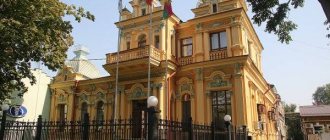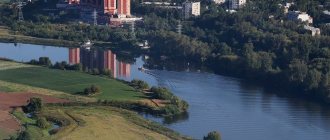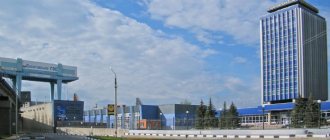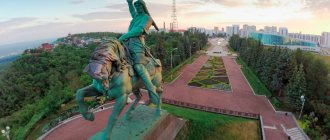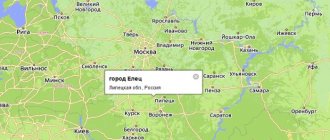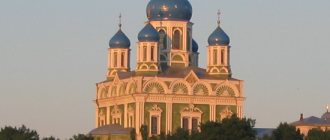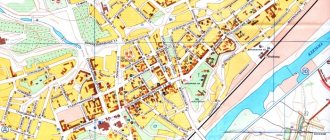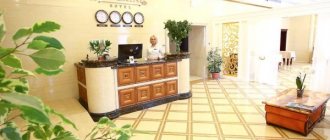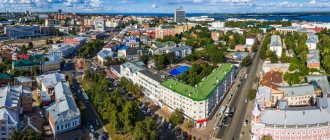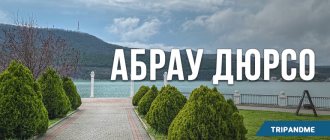Balakovo: what you must see on your own
The most significant sights of Balakovo are associated with the two main values of the city - history and industry.
Saratov hydroelectric power station and gateways
- Address: Zaovrazhnaya st., 10.
In the 1960s In Balakovo, on the banks of the Volga, a hydroelectric power station was built. The monumental construction required a lot of effort and resources; the work lasted 15 years. The resulting reservoir became the largest in the Saratov region. For more than half a century, the hydroelectric power station has been supplying water and electricity to local industry.
At the same time as the hydroelectric power station, builders built locks, from which a shipping embankment eventually stretched to the Drama Theater. Locals and visitors love to stroll along the embankment, watching the passing ships from above. From here there are some excellent views for photography.
House-Museum of V.I. Chapaeva
- Address: Chapaeva, 112.
Balakovo is the small homeland of Vasily Chapaev. This is where the red commander’s parental home is located, where he lived since he was 10 years old. The house is a small wooden hut; the windows have carved frames and shutters. The building preserved original items that belonged to the family of Vasily Ivanovich. Before the Civil War, the future commander worked as a carpenter; in one of the rooms you can see a sideboard made by the hands of a Soviet hero.
Many important events in Chapaev’s life are connected with this home. Here he brought his wife, who bore him two sons and one daughter, and from here he went to the front. While Vasily was fighting, his father was in conflict with his daughter-in-law. The young woman ran away more than once, but each time she had to return to her father-in-law. In the end, unable to withstand the pressure, his wife divorced Chapaev, leaving him with the children. After the death of Vasily Ivanovich, his daughter lived in the hut. In 1948, a museum in memory of the people's favorite was organized in the house.
Maltsev Estate
- Address: Kommunisticheskaya, 75.
Balakovo is rightly called a merchant city. Many beautiful buildings appeared in the settlement thanks to merchants, in particular, thanks to the famous Maltsev dynasty. One of the best examples of ancient architecture is the mansion of Paisiy Maltsev, the richest and most influential Balakovo resident of the late 19th and early 20th centuries.
Two talented architects worked on the appearance of the manor house at different times: F. Shuster and F. Shekhtel. The first built the mansion in the 1890s, the second was involved in its reconstruction in 1912. Shekhtel turned a modest provincial house into an exquisite palace in the spirit of aristocratic St. Petersburg.
After the Revolution, the estate began to be used for the needs of the Communist Party and the working people. At first, the district committee met in the mansion, and later a library was located. In 1998, the noticeably dilapidated building was handed over to restorers. Ten years later, the merchant's house turned into a museum.
The luxurious interior of the mansion amazes with its splendor. The one-story manor house is adjacent to a fairly large area, which includes a servants' house, a laundry room, a stable, a carriage house and a garden. Near the mansion there are lilac bushes planted about a hundred years ago.
Saratov HPP
- GPS coordinates:52.044010,47.769668
14 interesting sights of the city of Klaipeda
The Saratov hydroelectric power station is the seventh stage of the Volga-Kama cascade of hydroelectric power stations on the river. Volga. Its construction began in 1956, and in 1967 the power plant was put into operation. The Saratov hydroelectric power station is characterized by a non-standard design. It does not have a drainage dam, but has the longest turbine hall in Russia with a removable roof. The length of the dam is 1108 meters, making it the longest in Europe. The maximum height reaches only 40 meters. There are 24 hydraulic units installed at the hydroelectric power station; no other hydroelectric power station in the country has such a number. Large gantry cranes move on rails above the station. To replace the unit, the required section of the roof is dismantled and multi-ton equipment is removed using a crane. In addition to generating electricity, the Saratov hydroelectric station provides large-tonnage shipping, supplies water and irrigates arid lands.
Simultaneously with the construction of the hydroelectric power station, locks were built. Over time, a navigable embankment stretched from them all the way to the Drama Theater building. Walking along the promenade, guests can admire the passing ships from above, creating stunning scenery for memorable photographs.
Today, there is a museum in the administrative building of the hydroelectric power station. Entrance is free. But the hydroelectric power station itself is a protected facility, and in order to enter its territory you need to obtain permits.
Address: st. Zaovrazhnaya, 10, Balakovo
Interesting places in Balakovo
Balakovo will appeal to lovers of sports and active recreation. The city has facilities where both adults and children can exercise.
Children's park
- Coordinates on the map: 52.009683, 47.787543.
The largest playground for children is located in the city center. The children's park is the best place for walks and fun games in the fresh air. While the kids are having fun on the slides and attractions, adults can sit on comfortable benches or in covered gazebos.
The main attraction of the park is the massive Ferris wheel, which offers a wonderful panorama of the city. There is also a workout area for visitors, a “Strawberry Kingdom” honor board, and a Summer Stage. There is also a small beach nearby.
The stadium "Trud"
- Coordinates: 52.010013, 47.764304.
The central city stadium is the sports heart of Balakovo. Various sporting events, football matches, local, national and even international competitions take place here. The main purpose of the site is competitions in a rare sport for Russia - speedway, or track racing on motorcycles.
Motorcycle sport began to develop in the region in the 60s of the last century. In 1965, a stadium was built in Balakovo, three years later the city had its own speedway club, Turbina, which exists to this day. Turbina coaches have raised more than one generation of talented racers. During its glorious history, the club became the champion of the USSR eight times and won the All-Russian competitions three times.
Today the stadium accommodates more than 10,000 fans, including 2,000 seats. The structure is regularly rebuilt and repaired, making the stands and tracks more comfortable and technologically advanced. Training and competitions do not stop even in winter: with the arrival of frost, the ice speedway season begins.
Palace of Culture
- Address: st. Leonova Embankment, 1A.
This is probably the main leisure facility in Balakovo that you can visit next to the Children's Park. There are all conditions for children's leisure time, various clubs are organized - with dancing, games and other fun, useful things.
And the Balakovo Palace of Culture often hosts various cultural events, and at a fairly high level. Regional stars often perform here. And on New Year's Day, matinees are usually held here.
Cinema "Mir"
- Address: Trnavskaya st., 1A.
Of course, Balakovo couldn’t do without a cinema - it’s called “Mir” here and occupies a rather old building, which, however, was recently restored. The interior has also undergone renovation work - now it is cozy and quite comfortable, as reviews say.
Many claim that this is a movie from their childhood - and this is true, since the institution has grown up for more than one generation. The cinema hall is good, clean, but the prices cannot be called low. Before watching a movie, there is a place to buy popcorn or coffee, as well as a good snack.
Saratov HPP
16 interesting sights of the city of Sestroretsk
Recommend a place
80
6
Saratov Hydroelectric Power Station (named after the Lenin Komsomol) is a hydroelectric power station on the Volga River in the Saratov region, in the city of Balakovo. Included in the Volga-Kama cascade of hydroelectric power stations. The design capacity of the hydroelectric power station is 1360 MW, the installed capacity is 1270 MW, the average annual output is 5.352 billion kWh. The HPP building has 24 hydraulic units operating at a design head of 9.7 m: 21 rotary-blade hydraulic units PL-20/661-VB-1030 with a capacity of 60 MW each, 2 horizontal capsule hydraulic units PL-20/548-GK-750 with a capacity of 45 MW (currently replaced by new 54 MW), 1 fishway hydraulic unit PL-661-VB-500 with a capacity of 10 MW. The equipment of the hydroelectric power station is outdated and is being replaced and modernized. The pressure structures of the hydroelectric power station form the large Saratov reservoir.
The Saratov hydroelectric power station was designed by the Hydroproject Institute.
Balakovo museums and theaters
Balakovo residents owe much of their cultural life to Saratov. The regional center shared museum funds with Balakovo, but the city itself also has unique historical objects and valuable exhibits.
Museum of History
- Address: Kommunisticheskaya st., 100.
The main museum of Balakovo is located in a one-story red brick house. The interesting building immediately catches the eye thanks to the corner turret with a high cone-shaped roof, which is crowned with a weather vane. The unusual mansion in the neo-Gothic style was built at the beginning of the 20th century and belonged to V.V. Golovanov, a local entrepreneur, banker and grain industrialist.
The Balakovo Museum opened in 1986 as a branch of the Saratov Museum of Local Lore. At first, the regional center transferred part of its funds to the younger brother, later, thanks to local historian A.A. Derevyanchenko, exhibits related to the history of Balakovo itself appeared in the museum. Inside, visitors will find exhibitions of antique furniture, clothing, dishes, books and other household items.
Art Gallery
- Address: Zaovrazhnaya st., 9.
The unassuming building from the late 19th century houses treasures of fine art. Initially, the building housed the Commercial and Industrial Bank; after the Revolution, the premises were confiscated and turned into a branch of the Saratov Museum. Like the original museum, the Balakovo branch is named after the writer and political figure A. N. Radishchev.
This name was given to the museum by its founder A.P. Bogolyubov, who was a close relative of the writer. The art gallery opened to visitors in 1977. Most of the collection are creations of Russian painters.
Drama Theater named after. E. Lebedeva
- Address: st. Titova, 2.
The only Balakovo professional theater began its work in 1997. The troupe included both beginning actors and experienced artists from Russia and Kazakhstan. Initially, the theater was called “Kovcheg”, but later received the name of the famous Balakovo resident, actor Evgeny Lebedev.
Theatrical performances diversified the cultural life of the city and quickly gained popularity among local residents. The drama theater is suitable for all age categories, as its repertoire includes performances for both adults and children.
Maltsev Estate
- GPS coordinates:52.042689,47.785243
This is one of the most important architectural attractions of the city of Balakovo. In 1886 P.M. Maltsev bought an estate in the city, which was located at the intersection of two main streets - Nikolaevskaya and Novouzenskaya. It was built according to the design of the architect F.I. Shuster. The estate consisted of a main house, a stable, a house for the servants, a laundry, and a carriage house. At the beginning of the twentieth century, the estate was decorated with artistic elements by F.A. Shekhtel. Griffins, amphorae, a coat of arms, lilies, angels, laurel wreaths, shepherdesses with pipes appeared on the buildings, which gave the estate a completely new luxurious look.
An important element of the architecture is the Greek amphora with a flame, which spoke of the owner’s love for a beautiful foreign woman. According to one legend, the estate was built for Paisiy Maltsev’s beloved. However, the girl still refused her admirer, and the built palace with a lilac garden was left without permanent owners.
You can visit the Maltsev estate from 9:00 to 18:00, from Tuesday to Saturday.
Address: Kommunisticheskaya, 75, Balakovo, Saratov region.
Architectural monuments of Balakovo
More than a hundred ancient buildings have been preserved in Balakovo. Certain architectural monuments have special historical significance.
Schmidt Trading House
- Address: corner of 20 Let VLKSM and Chernyshevsky streets.
At all times, the main source of wealth and prosperity of Balakovo was trade. Due to its favorable geographical position, the village attracted merchants from different parts of the Empire. Several trading houses were built in the village, some of which have survived to this day.
Among such institutions, the Schmidt trading house stands out. A.A. Schmidt was one of the most successful merchants in the village, working not only in Saratov, but also in neighboring Samara. The merchant offered a wide selection of goods from haberdashery to agricultural tools.
To conduct business, Schmidt built in 1912 a two-story building in the Art Nouveau style, popular in Balakovo at the beginning of the 20th century. Despite the distance from the capital, rural residents followed fashionable architectural trends. The corner bay window is decorated with two symbolic statues of ancient gods: Diana, the goddess of fertility, and Mercury, the patron of trade.
Belyakov Estate
- Address: Lenina, 9a.
Not far from Maltsev’s house is the estate of his successful colleague, merchant P.A. Belyakova. Pavel Alexandrovich was a contemporary of Paisiy Mikhailovich and came from the peasant class.
Having become rich, Belyakov decided to acquire his own estate, for which in 1890 he bought a plot of land in the center of Balakovo. After 11 years, a spacious brick house with a mezzanine grew on the site. The mansion has been preserved in its original form with only minor changes.
Sudakov's House
- Address: Kommunisticheskaya, 41.
Like many architectural monuments of Balakovo, the estate of M.E. Sudakova decorates Kommunisticheskaya Street. Houses on the streets in the old part of the city stand close to each other, forming a long wall. The small two-story mansion stands out among other ancient buildings with its narrow Dutch-style facade and unusual, beautiful decor. On the wall just under the roof there is a family monogram with the owner’s initials “M. E.S.” Despite the aristocratic gloss, the house belonged not to a nobleman, but to a peasant.
Commercial school
- Address: Lenina, 2.
At the beginning of the 20th century, philanthropist I.V. Kobzar organized the first educational institution for boys and girls in Balakovo. Ivan Vasilyevich wholeheartedly cared for the cause of public education and even gave his commercial club for these purposes. In 1909, the merchant built a new comfortable red brick building for the students. After the events of 1917, the school continued its work according to the new curriculum.
During World War II, classes temporarily ceased, and Nazi prisoners were kept in the building. After the end of the war, the former school was converted into the River School. Today, the century-old building is in dilapidated condition and requires major renovation. Some of the window openings on the second floor are blocked with bricks.
Shipyard
- Address: Kommunisticheskaya, 126.
Being a Volga city, Balakovo stands in the way of many ships. During Soviet times, a ship repair plant was built on the shore. The enterprise remained one of the most profitable in the city for a long time. During the Great Patriotic War, the plant had to temporarily change its profile and produce military equipment.
By 1975, production was moved to another location, the old building turned out to be unnecessary and was abandoned. Today, only ruins overgrown with grass and bushes remind of the first plant.
In the harsh 90s, the enterprise suffered the fate of many of its brethren in the former USSR: due to financial crises, production stopped, people lost their jobs. Over time, the owners managed to get out of the economic hole and resume operation of the plant.
Fire Tower
- Address: 20 let VLKSM street, 67.
The red brick fire station building was built over a hundred years ago in 1913. In those days, an integral part of such buildings was a watchtower - a watchtower, from which the guards on duty surveyed the settlement and, upon seeing the smoke of a fire, immediately sounded an alarm. The architect, who worked on the Balakovo tower project, took a creative approach to his work and made the tower not only practical and comfortable, but also beautiful.
Narrow loophole windows cut through the walls of the building, the lower tier is illuminated by round glazed windows. The roof resembles an oriental pagoda. Today, the fire service no longer needs a tower; its functions are performed by all kinds of technical devices. The beautiful tower is used as a tower for antennas.
News
Archive
10 December 2022, 19:23
An employee of a kindergarten in Saratov fell ill with tuberculosis
10 December 2022, 18:44
Pobeda did not return the money for the plane ticket to the sick resident of the region. She won the trial, but she will have to wait three years
10 December 2022, 18:30
In Saratov, trams were stopped due to an accident during rush hour
10 December 2022, 18:03
Honey, milk and bread: residents and guests of Saratov are invited to fairs to buy goods from farmers
10 December 2022, 17:37
Saratov residents are warned about scammers who sell tickets to circus performances at half price in messengers
10 December 2022, 17:36
A city dweller was walking through the plantings in the Zavodskoy district and found a corpse
10 December 2022, 17:15
The Saratov region no longer meets all five criteria for a coronavirus-free region
10 December 2022, 17:13
“Employees are stressed, family is stressed”: a mother with many children told what she has to go through to get travel passes for her children
10 December 2022, 17:09
In Saratov, the opening date of Christmas tree markets and places of sale have been determined (full list of addresses)
10 December 2022, 17:08
Shareholders of a problem house, the completion date of which was postponed until next year, intend to go to a rally
10 December 2022, 16:41
Officials do not allow trees to be planted to replace those that have been cut down. Proposed to pay "replacement cost"
10 December 2022, 16:32
Residents of Saratov were alarmed by the mass removal of bodies on a truck from the city morgue: the management of the institution explained what was happening
10 December 2022, 16:18
The court declared a disinfectant working in a Saratov nursing home bankrupt due to a million-dollar debt.
10 December 2022, 16:04
The kindergarten and two more houses on 4th Dachnaya were recognized as urban planning monuments
10 December 2022, 15:54
The authorities propose to take more money from Russians who have tuned their cars, installed a towbar or gas equipment
10 December 2022, 15:44
Pokrovchanin took out more than a million rubles on credit and became a victim of “investors”
10 December 2022, 15:15
Three friends came to visit the village of Aleksandrovka, killed a drinking companion and almost stabbed another man to death: the accused were taken into custody
10 December 2022, 15:12
The State Duma proposes to introduce a fine of several thousand rubles for smoking near children and pregnant women
10 December 2022, 14:58
In Engels, doctors responded to a call to a 31-year-old man lying on the ground near a house, but did not have time to save him
10 December 2022, 14:55
“You shouldn’t do that with people”: a resident of Saratov “caught” the State Duma speaker on the street and spoke out against QR codes
10 December 2022, 14:51
“Either you can’t get through, or there’s no doctor, or something else”: Pokrov residents said that they couldn’t make an appointment for their children on the only allocated day
10 December 2022, 14:42
Entrepreneurs of the Volga region submitted more than 2.7 thousand applications for a preferential loan
10 December 2022, 14:35
A woman tried to commit suicide on the Balakovo bridge
10 December 2022, 14:28
Energy sector: debtors pay for heat with household appliances
10 December 2022, 14:25
In the Saratov region, following the rest of the country, they will begin vaccinating teenagers against Covid. Local officials are waiting for “directives” to the regions
10 December 2022, 13:56
Tele2 and world leader Plintron will launch virtual operators in Russia
10 December 2022, 13:37
Buyers clashed at a berry stand at the market: this led to the initiation of a case
10 December 2022, 13:27
Russian Health Minister: the first stage of vaccination against coronavirus among schoolchildren will be carried out this month
10 December 2022, 13:18
The woman wanted to avenge her son on the policeman and became involved in a criminal case
10 December 2022, 13:17
Schoolchildren from Dagestan, St. Petersburg and Voronezh figured out how to attract tourists to Saratov
Temples and monasteries of the city of Balakovo
In Balakovo and the surrounding area there are several Orthodox churches and one Muslim mosque. Some churches previously belonged to Old Believers.
Church of the Holy Trinity
- Address: Naberezhnaya st., 1B, Old Town microdistrict.
The main Old Believer church of the city differs from the usual Orthodox buildings due to its unusual architecture in the Art Nouveau style. From a distance, the church building resembles a medieval castle with a high tower and strict walls. Above the main entrance there is a mosaic icon of the Old Testament Trinity.
Plans for construction arose after 1905, when Emperor Nicholas II issued a decree allowing the Old Believers to have their own stone churches. The religious building was erected in 1913 according to the design of the architect Shekhtel, who considered the unusual church his best creation. The Maltsev merchants donated money for the construction.
In the 1930s, the church passed into the hands of a new government. The building was looted and partially rebuilt, destroying the five-tiered iconostasis and beautiful mosaic frescoes. Not a trace remained of the former wealth: icons, silver utensils and bells were irretrievably lost.
During the Soviet years, theatrical performances and dance evenings were held here. Only in 1989 the temple was returned to believers, restoration began and it was re-consecrated. Today services are held again in the church.
Church of the Nativity
- Address: Trnavskaya st., 22.
The history of the most unusual building in Balakovo began in 2003 with the construction of a small chapel of the Epiphany. When a new large church in honor of the Nativity of Christ grew nearby, the chapel began to be used as a baptismal church. The Church of the Nativity is a wonderful example of modern architecture.
The facade of the building consists of three convex parts of different sizes; a bell tower adjoins the building to the right of the main entrance.
The gilded domes shine especially brightly against the background of the dark green roof. The area around the temple is landscaped; paved paths lead to all buildings, along which lanterns are installed and flower beds are planted. The solemn consecration of the Orthodox parish took place in 2016.
Irgiz Resurrection Monastery
- Address: Beregovoy village, Balakovo district.
The men's monastery on the Irgiz River near Balakovo is one of the first Old Believer monasteries in Russia. Even in the first half of the 18th century, many families of schismatics fled to Irgiz. In 1762, Catherine II granted concessions for adherents of the “old faith”, after which several monasteries appeared in the surrounding area.
Presumably in 1763, the monk Abraham and his followers founded a men’s monastery 32 km from the village. Soon the fame of the strict ascetic life of the inhabitants spread throughout the settlement and pilgrims and those who thirsted for spiritual achievements flocked to the monastery.
The monastery quickly grew, and a year later the monks built the first chapel in honor of St. Nicholas the Wonderworker. The new monastery was named Nizhne-Voskresensky. The prefix “lower” indicated that it stood lower downstream than other monasteries.
At the beginning of the 19th century, the Resurrection Monastery was already inhabited by several hundred monks and novices. By that time, the monastery had become one of the most revered and influential in the area. In 1827, Emperor Nicholas I began to oppress the Old Believers. Following the instructions of the monarch, the new governor in 1828, through deception and pressure, forced the brethren to accept the same faith.
After the October Revolution, the monastery was closed and transformed into a psychoneurological dispensary. The communists dismantled the churches, and hospital patients settled in the cells. In 2005, the surviving buildings were transferred to the Russian Orthodox Church. Now one of the churches has been restored, and monastic life is being revived in the monastery.
Cathedral Mosque
- Address: Academician Korolev highway.
A significant part of the religious people in Balakovo are Muslims. Several years ago, adherents of Islam built a small mosque in the city. The white-walled building with a green roof has become one of the decorations of the area. The Islamic temple has a library and provides Islamic lessons for children.
Desert Island
- GPS coordinates:52.030298,47.674228
Desert Island is one of the most favorite vacation spots for guests and residents of the city of Balakovo. Despite the fact that it is located several kilometers from the settlement, administratively the island is part of the neighboring Volsky district.
The area of the island is approximately the same as the city of Balakovo, and the most interesting thing is that almost all of its shores are suitable for swimming. The coastline is covered with fine sand, which is sure to appeal to both adults and children. The island can only be reached by boat, so there are never large crowds of people here. And towards evening the beaches are empty, and only those who came here with tents remain on the shore. Some stay here for weeks, going into town only to replenish food and water supplies. It is better to visit the island in the warm season, so that you can fully enjoy the water treatments, soak up the sun and take bright photos against the backdrop of sunsets and sunrises. The entire territory of Pustynny is accessible for walking.
In the city of Balakovo, as well as in its surroundings, there are a large number of interesting places that will definitely appeal to tourists of all ages. Amazing architectural structures, religious buildings, and museums are concentrated here. And thanks to the rich natural potential, there are conditions for active pastime.
Balakovo monuments and sculptures
Near many cultural sites in the city you can see stone or bronze monuments. Balakovo residents made dedications to some famous and important people in the history of the settlement.
Avenue of Heroes
- Address: Torch of Socialism street.
The memorial complex is dedicated to participants in three wars: the Great Patriotic War, military campaigns in Afghanistan and Chechnya. There is a stele in the middle of the memorial, howitzers are installed on both sides of the monument, and the Eternal Flame burns between them.
A little to the side there is a monument to a Soviet soldier; behind the bronze figure there are slabs with portraits of local heroes. Along the green alley there are posters with photographs of war participants. Following the names of soldiers and officers is a story about their exploits and awards.
Monument to V.I. Chapaev
- Address: Sverdlova street.
Vasily Ivanovich truly became a folk hero, a character in Soviet jokes. The Red Commander became famous throughout the Soviet Union thanks to the book by D. Furmanov, and later the film “Chapaev”. Quotes from the film went viral and gave rise to hundreds of humorous stories about Chapaev, his young comrade Petka and the beautiful Anka the machine gunner.
Vasily Ivanovich’s fame also touched Balakovo, where the future division commander lived since childhood. Balakovites installed a bronze bust of the commander near Chapaev’s house. Every year, on the day of the death of the people's favorite, local residents come to lay flowers at the granite pedestal.
Monument to E.A. Lebedev
- Address: Titova street, Zhilgorodok microdistrict.
Evgeniy Aleksandrovich is a talented Soviet theater and film actor, a man of a broad soul and a difficult fate. The son of a repressed priest went through a difficult path to acting fame. For a long time, the Balakovites did not know that Lebedev was their fellow countryman. Local historian A.A. Derevyanchenko found out that the artist was born and lived in Balakovo until he was nine years old, after which he moved to Samara.
Evgeniy Alexandrovich was given the title of Honorary Citizen, and in 2001 a bust of the actor was installed near the Drama Theater building. Bronze Lebedev rests his head with one hand and thoughtfully looks into the distance. It is believed that the artist is depicted in one of his theatrical roles.
Monument to A.N. Radishchev
- Address: corner of Zaovrazhnaya and Moskovskaya streets.
A statue of the writer is installed near the Art Gallery. The stone monument is an exact copy of the monument that stood for a long time near the original Saratov Museum. Radishcheva. Alexander Nikolaevich is depicted from the waist up, dressed in clothes typical of his time. The writer folded his arms across his chest and turned his head towards the entrance, as if greeting museum visitors.
Monument to the Builders
- Address: Freedom Square.
Balakovo is a record holder in terms of industrial development. During the Soviet years, the city hosted as many as five All-Union construction projects, including the construction of a hydroelectric power station and a nuclear power plant. Balakov's industrial success was forged by workers from different parts of the vast country. In 2015, Balakovo residents immortalized the memory of the builders with a monument on one of the city streets.
Maltsev Estate
Recommend a place
99
13
The Maltsev estate is a museum, which is a palace in the city of Balakovo at the intersection of Novouzenskaya and Nikolaevskaya streets. This architectural monument of the 19th century belonged to the richest grain merchants. In 1886, this building was bought by Paisiy Mikhailovich Maltsev, a respected merchant and the most influential person in Balakovo at that time. Local residents believed that the Maltsevs had so much land that the whole of France could be placed on it.
The Maltsev estate is one of the rare luxurious provincial estates in Russia. It includes a beautiful main house, a cozy lilac garden, and a house with a utility block for servants. Also on the estate there is a carriage house, stables, laundry, original brickwork for the fence, and also a cast gate.
The Maltsev estate was in a ruined state until recently, but was restored within a few years. Today excursions and entertainment events are successfully held here. The main visitors to the Maltsev estate are newlyweds who want beautiful photographs and ceremonies in the ballrooms of the palace. In the estate you can arrange a family celebration and a simply gorgeous photo shoot.
Yesterday.
Balakovo is a large village with wooden huts. Only the center was decorated with stone two-story houses, mainly manufacturers, grain and livestock traders. ... the rest of the population either worked as laborers for merchants, or worked as petty traders, but all together drowned in an unshakable, seemingly settled, petty-bourgeois life for all eternity. ... on the outskirts of the city there were workshops where workers created engines almost manually, and on the Volga, above the piers, there was a backwater where steamships were gathered for the winter and stood frozen in the ice like dead men until spring navigation. Balakovo... That’s where life was, frozen like cast iron. F. Panferov
Geography
The city is located on the left bank of the Volga River (Lower Volga), 176 km northeast of Saratov.
The founders of the plant are the Mamin brothers
For a long time it was believed that the city of Balakovo was founded in 1762, but subsequently a document dated 1738 was discovered in the archives of St. Petersburg, which mentions the Cossack meadow property of Balakov Yurt, located two miles from the Volga. On December 14, 1762, Empress Catherine II of Russia issued a manifesto calling on the Old Believers, who had once fled to Poland, to return from abroad to Russia and settle on the lands between the Bolshoy and Maly Irgiz rivers. The zealots of the old faith were allocated 70,000 acres (76,300 hectares) of the best Trans-Volga land for use. Returning Old Believers founded several new settlements, including the village of Balakovo. In 1861, 2,700 people lived in the village of Balakovo. Its convenient location on shipping routes helped the village grow rapidly through the wheat trade. In one season, up to 10 million poods of bread were sent from Balakovo. More than 300 spacious barns located on the bank of Balakovka made it possible to store grain from harvest to harvest. In the 60s of the 19th century, during one navigation, up to 180 barges with cargo could depart from Balakovo. Another product that Balakovo merchants traded in large quantities was timber. Balakovo was an intermediary between the forest provinces of the Upper Volga region and the treeless Trans-Volga steppe. Here, from rivers such as the Kama, Belaya, and Vyatka, up to 500 thousand pounds of firewood and up to three million pounds of forest building materials were brought annually. Some of this timber was processed at two sawmills.
Commercial School named after. Kobzarya I. V
With the development of trade, the cargo turnover of the piers grew, and the fleet of cargo and passenger ships increased. A ship repair industry was created to repair them. In 1897, the population of the village reached 18,388 people.
The beginning of the 20th century was marked by a significant expansion of the borders of the village, as well as an increase in the number of industrial enterprises. In May 1911, the Highest Decree was signed granting Balakov the status of a city with self-government rights. And the first mayor was industrialist Ivan Mamin. On the eve of the 1917 revolution, the city had 6 churches, 7 schools, a grain exchange, an iron foundry of Fyodor Blinov and a mechanical plant for oil engines of the Mamin brothers, ship repair and furniture workshops, sawmills, mills, a commercial school opened back in 1910 with significant financial assistance from the merchant - philanthropist Ivan Kobzar, a zemstvo hospital and a city factory outpatient clinic (clinic), a library, and a power plant, which was organized by the Svet partnership.
Self-taught inventors Fyodor Abramovich Blinov and Yakov Vasilyevich Mamin glorified Balakovo as the birthplace of the world's first caterpillar tractor, wheeled self-propelled vehicle and Russian diesel engine. In 1915, the Y. V. Mamin Oil Engines and Tractor Plant produced 325 diesel engines with a total capacity of 5,100 horsepower. The appearance of old Balakovo was created by such architects as H. F. Meyer and academician F. O. Shekhtel. Carefully preserving and restoring the historical landscape of the central part, Balakovo residents are constantly improving the appearance of a new, young city with spacious alleys, arrow-straight avenues, slender buildings with elegant facades.
USSR
Until 1928, Balakovo was part of the Samara province (in 1919-1924 there was a Balakovo district), after - the Lower Volga region, from December 5, 1936 - into the Saratov region.
In the period from 1956 to 1971, the Saratov hydroelectric power station was built in Balakovo, which led to the overflow of the Volga and the flooding of part of the coastal area and a change in the appearance of the modern city, as well as its sharp growth associated with obtaining the necessary electricity. In a short time, the Balakovo industrial complex was created, numbering more than two dozen enterprises in the chemical, mechanical engineering, energy, construction industry, and food industries. In 1985, the first power unit of the Balakovo NPP was put into operation, which currently (2010) has 4 operating power units.
Based on the results of the referendum on December 22, 1996, the Balakovo municipal formation was created, which included the city of regional subordination of Balakovo and the rural Balakovo district. In 2004, the Balakovo municipal formation was renamed the Balakovo municipal district
